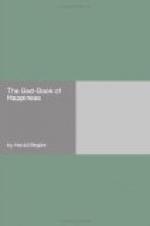C. A room for reducing Fractions to their Lowest Terms. This should be provided with a cellar for keeping the Lowest Terms when found, which might also be available to the general body of Undergraduates, for the purpose of “keeping Terms.”
D. A large room which might be darkened, and fitted up with a magic-lantern, for the purpose of exhibiting circulating Decimals in the act of circulation. This might also contain cupboards, fitted with glass doors, for keeping the various Scales of Notation.
E. A narrow strip of ground, railed off and carefully levelled for investigating the properties of Asymptotes, and testing practically whether Parallel Lines meet or not: for this purpose it should reach, to use the expressive language of Euclid, “ever so far.”
This last process of “continually producing the lines,” may require centuries or more; but such a period, though long in the life of an individual, is as nothing in the life of the University.
As Photography is now very much employed in recording human expression, and might possibly be adapted to Algebraical Expressions, a small photographic room would be desirable, both for general use and for representing the various phenomena of Gravity, Disturbance of Equilibrium, Resolution, etc., which affect the features during severe mathematical operations.
May I trust that you will give your immediate attention to this most important subject?
Believe me,
Sincerely yours,
MATHEMATICUS....
[Sidenote: Miss E.G. Thomson]
It was at the end of December, 1878, that a letter, written in a singularly legible and rather boyish-looking hand, came to me from Christ Church, Oxford, signed “C.L. Dodgson.” The writer said that he had come across some fairy designs of mine, and he should like to see some more of my work. By the same post came a letter from my London publisher (who had supplied my address) telling me that the “Rev. C.L. Dodgson” was “Lewis Carroll.”
“Alice in Wonderland” had long been one of my pet books, and, as one regards a favourite author as almost a personal friend, I felt less restraint than one usually feels in writing to a stranger, though I carefully concealed my knowledge of his identity, as he had not chosen to reveal it.
This was the beginning of a frequent and delightful correspondence, and, as I confessed to a great love for fairy lore of every description, he asked me if I would accept a child’s fairytale book he had written, called “Alice in Wonderland.” I replied that I knew it nearly all off by heart, but that I should greatly prize a copy given to me by himself. By return came “Alice,” and “Through the Looking-glass,” bound most luxuriously in white calf and gold. And this is the grateful and kindly note that came with them: “I am now sending you ‘Alice,’ and the ‘Looking-glass’ as well. There is an incompleteness about giving only one,




